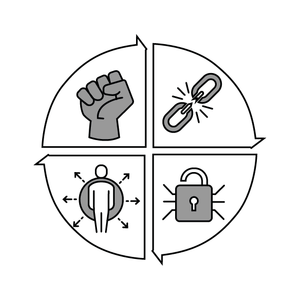SWOT analysis

The SWOT Analysis is a long-standing technique of looking at what we have, with respect to the desired end state, as well as what we could improve on. It gives us an opportunity to gauge approaching opportunities and dangers, and assess the seriousness of the conditions that affect our future. When we understand those conditions, we can influence what comes next.
Goal
To have a complete overview of our current situation considering strengths, weaknesses, opportunities and threats.
Materials
Instructions
Preparation
Before the meeting, write the phrase “Desired End State” and draw a picture of what it might look like on a piece of flip-chart paper.
Create a separate four-square quadrant using four sheets of flip-chart paper. If you think the complexity of the discussion and the number of players warrants more quadrants, create as many as you’d like.
- At the top left of the quadrant, write the word “STRENGTHS” and draw a picture depicting that concept.
- At the bottom left of the quadrant, write the word “WEAKNESSES” and draw a picture depicting that concept.
- At the top right of the quadrant, write the word “OPPORTUNITIES” and draw a picture.
- At the bottom right of the quadrant, write the word “THREATS” and draw a picture depicting that concept.
Flow
- Ask the players to take 5–10 minutes and quietly generate ideas about strengths they have with respect to the desired end state and write them on sticky notes, one idea per sticky note.
- Continue idea generation for the other 3 quadrants in the same manner as with the strengths quadrant.
- When you sense a lull in sticky-note generation, gather all of the sticky notes and post them on a flat surface that is near the quadrant and is viewable by the players. Be sure to keep the sticky notes in their original groups of strengths, weaknesses, opportunities, and threats.
- Start with the STRENGTHS group of sticky notes and, with the players’ collaboration, sort the ideas based on their affinity to other ideas. For example, if they produced three sticky notes that say “good sharing of information,” “information transparency,” and “people willing to share data,” cluster those ideas together. Create multiple clusters until you have clustered the majority of the sticky notes. Place outliers separate from the clusters but still in playing range. Repeat the clustering and sorting process for the other categories in this order: WEAKNESSES, OPPORTUNITIES, and finally, THREATS.
- After the sorting and clustering are complete, start a group conversation to create a broad category for each smaller cluster. For example, a category for the cluster from step 4 might be “communication”. As the group makes suggestions and finds agreement on categories, write those categories in the appropriate quadrant.
- When the players feel comfortable with the categories, ask them to approach the quadrant and dot vote next to two or three categories in each square, indicating that they believe those to be the most relevant for that section. Circle or highlight the information that got the most votes and make a note of it with the group.
- Summarize the overall findings in a conversation with the players and ask them to discuss the implications around the desired end state. Engage the group in a creative exercise wherein they evaluate weaknesses and threats positively, as though their presence is doing them a favor. Ask them thought-provoking questions, like “What if your competition didn’t exist?” and “How does this threat have the potential to make the organization stronger?”
Attachments
- SWOT analysis cover image.png
- SWOT analysis cover.PNG
- SWOT analysis.PNG
Background
This game was inspired by Albert Humphrey’s traditional SWOT Analysis.
Source: Gamestorming
Author
Gamestorming is a set of co-creation tools used by innovators around the world.
More about author